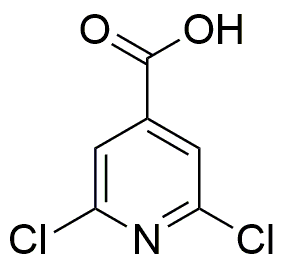2,6-Dichloroisonicotinic acid is widely utilized in research focused on:
- Pharmaceutical Development: This compound serves as a key intermediate in the synthesis of various pharmaceuticals, particularly in the development of anti-inflammatory and anti-cancer agents.
- Agricultural Chemicals: It is used in the formulation of herbicides and pesticides, helping to enhance crop protection and yield, making it valuable for the agricultural sector.
- Material Science: The compound is employed in the production of specialized polymers and resins, contributing to the development of materials with enhanced durability and chemical resistance.
- Analytical Chemistry: It acts as a reagent in various analytical techniques, aiding in the detection and quantification of other compounds, which is crucial for quality control in laboratories.
- Biochemical Research: Researchers utilize it to study biochemical pathways and interactions, particularly in the context of enzyme inhibition and receptor binding, providing insights into cellular processes.
General Information
Properties
Safety and Regulations
Applications
2,6-Dichloroisonicotinic acid is widely utilized in research focused on:
- Pharmaceutical Development: This compound serves as a key intermediate in the synthesis of various pharmaceuticals, particularly in the development of anti-inflammatory and anti-cancer agents.
- Agricultural Chemicals: It is used in the formulation of herbicides and pesticides, helping to enhance crop protection and yield, making it valuable for the agricultural sector.
- Material Science: The compound is employed in the production of specialized polymers and resins, contributing to the development of materials with enhanced durability and chemical resistance.
- Analytical Chemistry: It acts as a reagent in various analytical techniques, aiding in the detection and quantification of other compounds, which is crucial for quality control in laboratories.
- Biochemical Research: Researchers utilize it to study biochemical pathways and interactions, particularly in the context of enzyme inhibition and receptor binding, providing insights into cellular processes.
Documents
Safety Data Sheets (SDS)
The SDS provides comprehensive safety information on handling, storage, and disposal of the product.
Product Specification (PS)
The PS provides a comprehensive breakdown of the product’s properties, including chemical composition, physical state, purity, and storage requirements. It also details acceptable quality ranges and the product's intended applications.
Certificates of Analysis (COA)
Search for Certificates of Analysis (COA) by entering the products Lot Number. Lot and Batch Numbers can be found on a product’s label following the words ‘Lot’ or ‘Batch’.
Número de catálogo
Número de lote/lote
Certificates Of Origin (COO)
This COO confirms the country where the product was manufactured, and also details the materials and components used in it and whether it is derived from natural, synthetic, or other specific sources. This certificate may be required for customs, trade, and regulatory compliance.
Número de catálogo
Número de lote/lote
Safety Data Sheets (SDS)
The SDS provides comprehensive safety information on handling, storage, and disposal of the product.
DownloadProduct Specification (PS)
The PS provides a comprehensive breakdown of the product’s properties, including chemical composition, physical state, purity, and storage requirements. It also details acceptable quality ranges and the product's intended applications.
DownloadCertificates of Analysis (COA)
Search for Certificates of Analysis (COA) by entering the products Lot Number. Lot and Batch Numbers can be found on a product’s label following the words ‘Lot’ or ‘Batch’.
Número de catálogo
Número de lote/lote
Certificates Of Origin (COO)
This COO confirms the country where the product was manufactured, and also details the materials and components used in it and whether it is derived from natural, synthetic, or other specific sources. This certificate may be required for customs, trade, and regulatory compliance.


